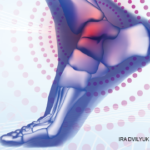Sharma et al published the results of a study that they believed showed, for the first time, that abnormal alignment of only five degrees (as measured from the ankle to the hip) increased the progression of OA four to five times, and could be seen as soon as 18 months after being identified. They concluded that OA was therefore a result of “local mechanical factors.”30 In their study, Khan et al confirmed that, “previous studies have shown that lower extremity malalignment increases the risk and rate of progression of knee osteoarthritis.”3 Their own study showed that, for each degree of malalignment in people who already had some arthritis there was a 53% average increase risk of its progression. They also found that increasing age was weakly associated with an increase risk of osteoarthritis of the knee. They concluded by noting that alignment has been cited as one of the most important risk factors for the progression of osteoarthritis and that “there is a clear relationship between overall limb alignment and … osteoarthritis of the knee.”
In their study, Janakiramanan et al confirmed Kahn’s findings on the important effect that even the slightest degree of abnormality had on arthritis. According to researchers, even a one-degree abnormality in alignment is associated with an increased risk of cartilage damage in those with arthritis.31 They also reported that malalignment increased joint-space narrowing. A systematic review of the literature published in Arthritis & Rheumatism concluded that, “malalignment of the knee joint was found to be an independent risk factor for the progression of knee OA.”32 One comprehensive study followed more than 1,500 participants for a mean of 6.6 years and found that poor alignment was associated with an increase in the development of osteoarthritis.33
Finally, in April 2009, the Centers for Disease Control and Prevention and the Arthritis Foundation organized expert working groups to develop white papers for discussion at an OA summit meeting. More than 80 people from 50 organizations came together to talk about the status of public health interventions for this disease. Their report stated, “the pivotal importance of mechanical factors to osteoarthritis symptoms and progression is undeniable.”34

